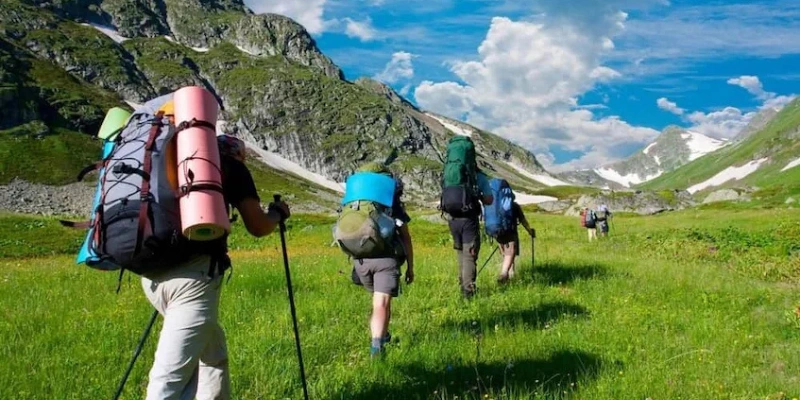Why the confusion?
When you hear someone talk about heading out into the world, they often say they’re going – or hiking? These two words are often used interchangeably, and it’s easy to assume they mean the same thing. However, while both involve walking in nature, trekking and hiking are distinct experiences.
So why the confusion? The truth is that hiking and walking have many similarities – both offer physical exercise, a chance to spend time in nature, and get away from the hustle and bustle of everyday life. However, there are key differences in duration, difficulty, purpose, and even the terrain they cover. It’s important to understand these differences, especially for beginners or anyone planning their next outdoor adventure. Choosing the right activity can be the difference between an enjoyable trip and an exhausting experience.
Whether you’re dreaming of a multi-day expedition through the Himalayas or a short scenic hike along a nearby trail, knowing what to expect can help you be better prepared and make the most of your experience. This guide will explain the real difference between trekking and hiking and help you decide which one best suits your goals, lifestyle, and level of adventure.
Ready to clear up the confusion and find out what it means – and if it’s the right choice for you? Let’s discuss it in detail.
Defining the Basics: Hiking vs Trekking
To truly understand the difference between hiking and trekking, it’s important to go back to basics. While both activities involve exploring nature on foot, they differ significantly in terms of duration, difficulty, and the kind of environment they take place in.
What is Hiking?
Hiking means walking short distances on marked trails, usually completed in a day or a weekend. These trails are often maintained and signposted, making them ideal for beginners, casual hikers, or anyone who wants to spend a relaxing day outdoors. Hiking trails typically run through scenic routes in forests, mountains, or national parks, often at low elevations and with manageable gradients.
Because of its ease and accessibility, hiking is a favorite choice for families, nature lovers, and people new to outdoor activities. It allows you to reconnect with nature without the need for extensive planning, training, or special gear.
What is trekking?
Trekking, on the other hand, is a more immersive and challenging form of adventure. Unlike hiking, trekking involves traversing challenging terrain for several days, which may include steep climbs, rocky paths, river crossings, and remote areas. It often takes place at high altitudes or in isolated environments, where facilities and support systems are minimal or nonexistent.
The essence of lies in the journey itself – a journey that tests your endurance, adaptability, and mental strength. Trekkers often camp overnight, carry the bare essentials, and sometimes make their way without any marked path. Whether it is an expedition through the Himalayas, Patagonia, or the Sahyadri Hills, every trek offers a unique experience shaped by both nature and personal resilience.
Unlike hiking, trekking requires a high level of preparation, fitness, and commitment. It attracts people who seek adventure, cultural discovery, and a break from the modern world. Trekkers often return with a deeper connection to nature and a greater sense of accomplishment.
Why does this difference matter?
Understanding the difference between hiking and trekking can help outdoor enthusiasts choose the right experience for their skill level and expectations. Hiking is perfect for a spontaneous weekend outing, while it is suitable for those who want to get off the beaten path and enjoy nature.
So before you lace up your shoes, ask yourself: Are you planning a casual walk in the woods, or are you ready for a true trekking adventure?
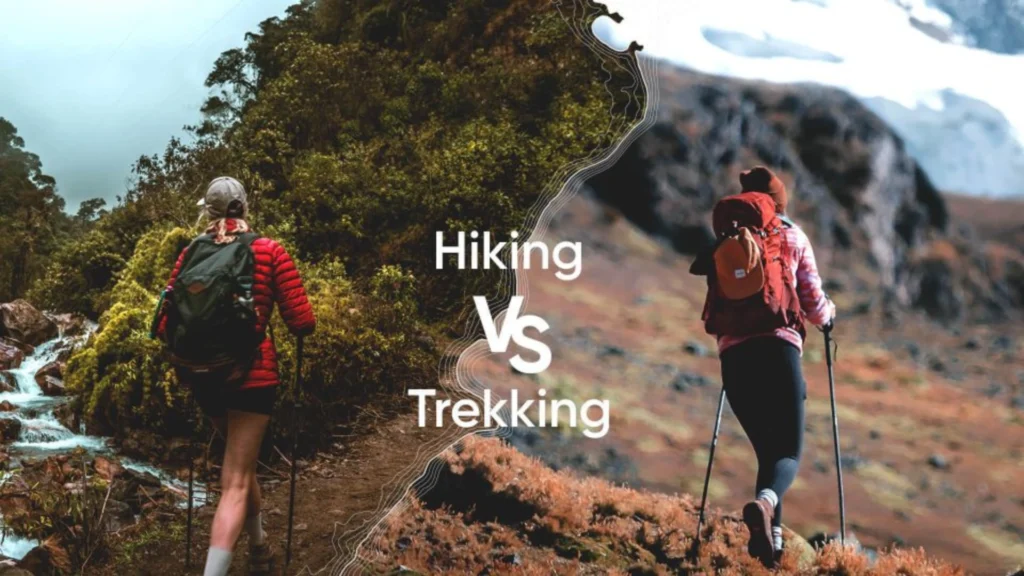
Key Differences Between Trekking and Hiking
At first glance, hiking and trekking may seem like similar outdoor activities, but they are quite different in several essential ways. Understanding these differences will help you choose the right experience based on your fitness level, time availability, and personal adventure goals. Let’s understand the key factors that differentiate trekking from hiking:
1. Duration: Hours vs. Days
Hiking is typically a short-duration activity. Most hikes last a few hours and can be completed in a day or a weekend. It’s perfect for those who want to escape into nature without traveling long distances.
However, often lasts several days. It’s not uncommon for an expedition to last a week or even longer, especially in remote or mountainous areas. Trekkers should plan for overnight stays, rest breaks, and daily long walks in different terrain.
2. Intensity: Comfort vs. Endurance
Hiking is leisurely and suitable for most fitness levels. Trails are designed for enjoyment and relaxation, making hiking an ideal choice for families, beginners, or anyone looking for light exercise.
It is far more intense and physically demanding. A route can involve steep climbs, elevation changes, river crossings, and long walks each day. This challenges your stamina, strength, and mental endurance, making it a true test of both body and mind.
3. Terrain: Maintained trails vs. wild landscapes
Hiking trails are usually well-marked and maintained by park services or local authorities. Paths are easy to follow, and hazards are minimal.
In contrast, trekking routes often pass through rugged, unmarked, or even unknown areas. Trekkers traverse dense forests, rocky slopes, remote mountain passes, or desert landscapes. The unpredictable nature of the terrain is what makes it so thrilling and rewarding.
4. Essentials: Lightweight pack vs. full kit
For hiking, you only need the basics—comfortable shoes, water, snacks, and maybe a daypack. Most hikers return to the trailhead by evening and don’t need to carry extra gear.
Trekking, on the other hand, requires a more serious packing list. Trekkers often carry tents, sleeping bags, cooking equipment, weather-proof clothing, and a first-aid kit. Gear depends on the length and difficulty of the trekking route, but it usually includes everything needed to survive several days in the wilderness.
5. Accommodation: Home base vs. on the trail
Hikers usually return to a hotel, lodge, or home base at the end of the day. Accommodation is comfortable and easily accessible.
However, trekkers sleep on the trail—either in tents, remote mountain huts, homestays, or basic guesthouses. Since trekking routes often lead deep into nature away from towns or cities, accommodations can be minimal, rustic, or even self-supported.
6. Purpose: Fun outing vs. life-changing experience
The main goals of hiking are recreation, fitness, and relaxation. It’s an enjoyable way to spend time in nature without investing too much in planning or training.
Trekking is more than just walking—it’s about pushing your limits, exploring remote places, and discovering new landscapes and your abilities. Many people find trekking to be a deeply transformative experience that leaves lasting memories and a sense of accomplishment.
Final thoughts
While both hiking and trekking have their charm, knowing their main differences can help you choose the trip that best suits your adventurous spirit. If you are looking for a peaceful walk amidst nature, hiking might be perfect. But if you are up for a challenge, a connection to wild landscapes, and the thrill of exploration, trekking might be exactly what you are looking for.
Start your journey – whether it is a short trip or a high-altitude trekking adventure.
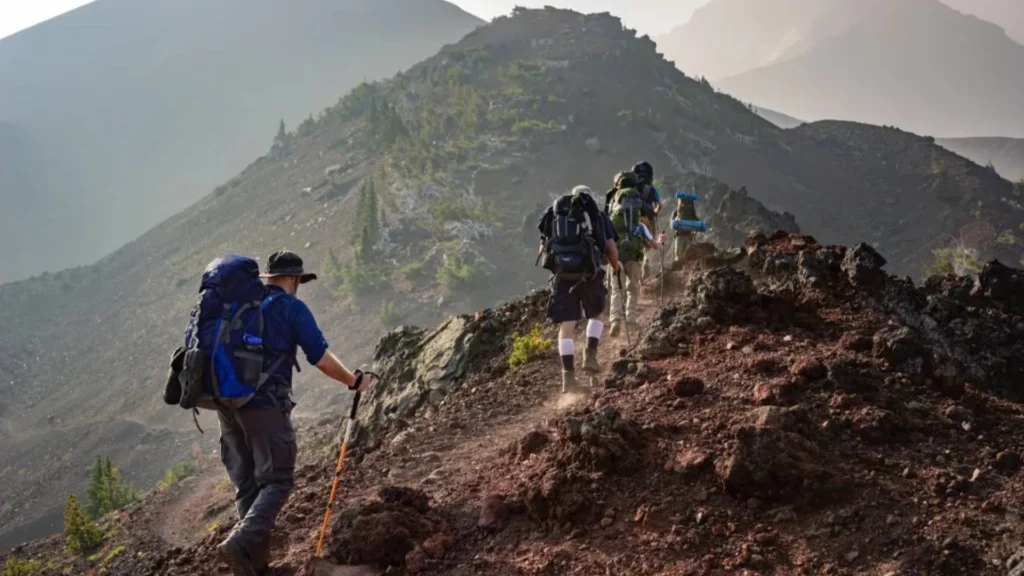
Which is right for you?
Choosing between hiking and trekking depends on several personal factors—your fitness level, your desire for adventure, and how much time you can dedicate to the experience. While both offer unique benefits, they cater to different types of outdoor enthusiasts. Asking yourself the right questions can help determine which path is best suited for you.
1. How fit are you?
Your current fitness level plays a major role in deciding whether to go hiking or trekking. Hiking is usually of light to moderate intensity, making it a great option for beginners, casual walkers, or those returning to physical activity after a break. The trails are usually short and manageable without intense physical preparation.
However, trekking requires a high degree of physical and mental stamina. If you can comfortably walk long distances for several days, carry a loaded backpack, and handle elevation changes or rough terrain, trekking may be the adventure you’re ready for. It’s not just a physical challenge—it’s a test of flexibility and stamina.
2. What’s your adventure level?
Think about how far out of your comfort zone you’re willing to go. Are you looking for a pleasant, peaceful escape into nature, or do you crave the thrill of remote exploration? Hiking allows you to enjoy beautiful scenery, wildlife, and fresh air without leaving behind the comforts of nearby civilization.
If you’re someone who seeks the unknown, values solitude, and finds joy in pushing boundaries, trekking may satisfy your adventurous spirit. Whether you’re crossing high mountain passes or walking through dense forests, trekking offers a deep connection to nature and a strong sense of accomplishment.
3. How much time can you commit?
Time is an important factor when choosing between hiking and trekking. Hikes can often be done in the morning or afternoon, making it ideal for weekend plans or a quick getaway.
Trekking, on the other hand, typically requires more time. Many trekking routes last several days, and some even weeks. This involves planning, preparation, and traveling to often remote starting points. If you have the time and want to immerse yourself in nature, trekking is your best option.
A simple tip
If you’re just starting in outdoor activities, hiking is the best way to build confidence, improve fitness, and fall in love with the natural world. It’s low-risk, accessible, and offers instant gratification.
But if you’re up for a deeper challenge, willing to explore remote and rugged terrain, and are prepared to push beyond your limits, trekking will provide you with an unforgettable experience. From the Himalayas to the Andes, trekking can turn your love of the outdoors into a life-changing adventure.
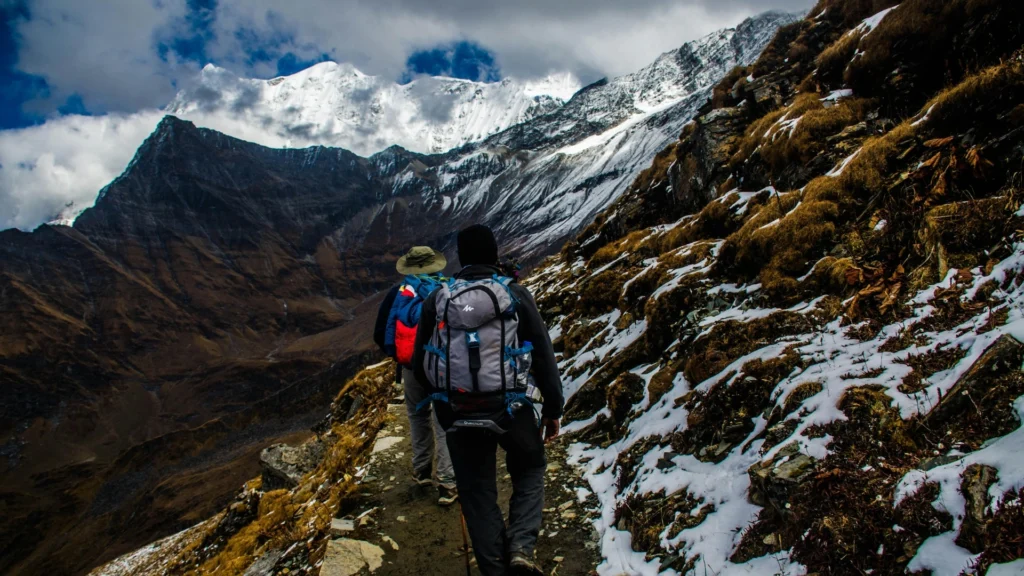
Benefits of Each: Why Hiking and Trekking Are Both Worth a Try
Whether you’re lacing up your boots for a nature walk or preparing for a multi-day wilderness trip, both hiking and trekking offer unique benefits. Understanding the benefits of each can help you decide which outdoor experience best fits your lifestyle, fitness level, and personal goals.
Benefits of Hiking
Hiking is one of the most accessible and beginner-friendly outdoor activities, and it has many benefits:
1. Easy to Get Started
One of the biggest benefits of hiking is how easy it is to get started. You don’t need expensive gear or months of training. With a pair of good walking shoes, a bottle of water, and a sense of adventure, you can hit the trail almost anywhere and enjoy the outdoors.
2. Good for Physical and Mental Health
Hiking is a great way to stay active without putting too much stress on your body. It improves cardiovascular health, strengthens muscles, and boosts endurance. Mentally, hiking can reduce stress, improve your mood, and provide a refreshing break from screens and city noise.
3. Great for a quick escape
For those who have limited time, hiking is the perfect solution. Whether it’s a short trip after work or a weekend getaway in the mountains, hiking allows you to reconnect with nature without taking a vacation or traveling far from home. It’s a perfect mini-escape.
Benefits of Trekking
Although trekking is more demanding, it has many profound benefits of its own. For those who are ready to accept the challenge, trekking offers unmatched experiences and personal growth.
1. Builds Stamina and Strength
Trekking is a full-body workout. It tests and strengthens your legs, core, shoulders, and mental flexibility. Walking for hours or days with a backpack over uneven terrain builds stamina, endurance, and patience. Over time, regular trekking improves fitness that far surpasses general exercise.
2. Provides cultural immersion and natural beauty
Unlike short hikes that are often on tourist-friendly routes, trekking takes you to lesser-known regions, where you can interact with local communities, discover traditional ways of life, and enjoy breathtaking landscapes that few people get to see. From remote mountain villages to untouched valleys, trekking is both an adventurous and cultural journey.
3. Builds a deeper connection with nature
When you spend several days surrounded by forests, rivers, peaks, and wildlife, you develop a richer connection to the natural world. Trekking forces you to slow down, observe your surroundings, and appreciate the natural beauty of the environment. It’s not just about reaching the destination—it’s about embracing the journey.
Tips
Both hiking and trekking are powerful ways to experience nature, stay healthy, and refresh your soul. If you are new to outdoor activities or short on time, hiking is the best way to start. But if you want an experience that thrills, challenges, and stirs your soul, trekking is the way to go.
Whichever route you choose, it will give you a much more physical satisfaction. So go ahead—get out there and start traveling.

Popular Hiking and Trekking Destinations
Whether you’re a weekend hiker or a seasoned trekker, the world is filled with stunning trails and breathtaking landscapes that cater to every level of adventure. From tranquil forests to snow-capped mountain passes, both hiking and trekking offer unforgettable experiences around the world. Here’s a look at some of the most popular destinations that outdoor lovers should add to their bucket list.
Top Hiking Destinations
If you’re new to hiking or simply prefer a shorter, more accessible nature experience, these destinations offer beautiful views and well-marked trails that are perfect for all skill levels:
1. Appalachian Trail, USA
Stretching more than 3,500 kilometers from Georgia to Maine, the Appalachian Trail is one of the world’s most famous hiking routes. While the full route is long, many hikers choose shorter sections for day hikes or weekend adventures through lush forests, rolling hills, and scenic ridgelines.
2. Banff National Park, Canada
Located in the heart of the Canadian Rockies, Banff is a hiker’s paradise. With turquoise lakes, high peaks, and wildlife-filled paths, it offers hikes for all levels. The easy-to-navigate trails make it ideal for those new to outdoor exploration who still want the wow factor.
3. Valley of Flowers, India
A UNESCO World Heritage Site, this Himalayan valley in Uttarakhand erupts in a riot of colors during the monsoon months. The trip to the valley is short and beginner-friendly, making it a perfect introduction to Himalayan hiking without a long trekking expedition.
Top Trekking Destinations
For those who seek adventure, endurance, and a deep connection with the wilderness, these world-renowned trekking destinations offer life-changing experiences:
1. Everest Base Camp Trek, Nepal
Being the most iconic trekking route in the world, this trail takes you through Sherpa villages, Buddhist monasteries, and high-altitude landscapes to the foothills of the world’s highest peak – Mount Everest. The trekking journey takes around 12-14 days and offers breathtaking views of the Himalayas at every step.
2. Inca Trail, Peru
This historic trekking route leads to the ancient ruins of Machu Picchu, combining cultural exploration with physical challenge. The Inca Trail is a multi-day trek through cloud forests, archaeological sites, and high mountain passes, making it one of the most rewarding trekking experiences in South America.
3. Chadar Trek, India
For true adventure lovers, Chadar Trek offers a unique winter trekking experience on the frozen Zanskar River in Ladakh. With temperatures dropping to -20 degrees Celsius, this trekking trip tests both physical and mental strength while offering surreal views of the Himalayas.
Final Thoughts
From relaxing hikes to intense trekking adventures, the world has no shortage of incredible trails that deserve to be explored. Whether you’re strolling through the serene landscapes of Banff or pushing your limits on the Chadar Trek, both hiking and trekking offer unique glimpses into the beauty of our planet.
So, choose your route—whether it’s a half-day hike or a two-week trekking trip—and let nature lead the way.
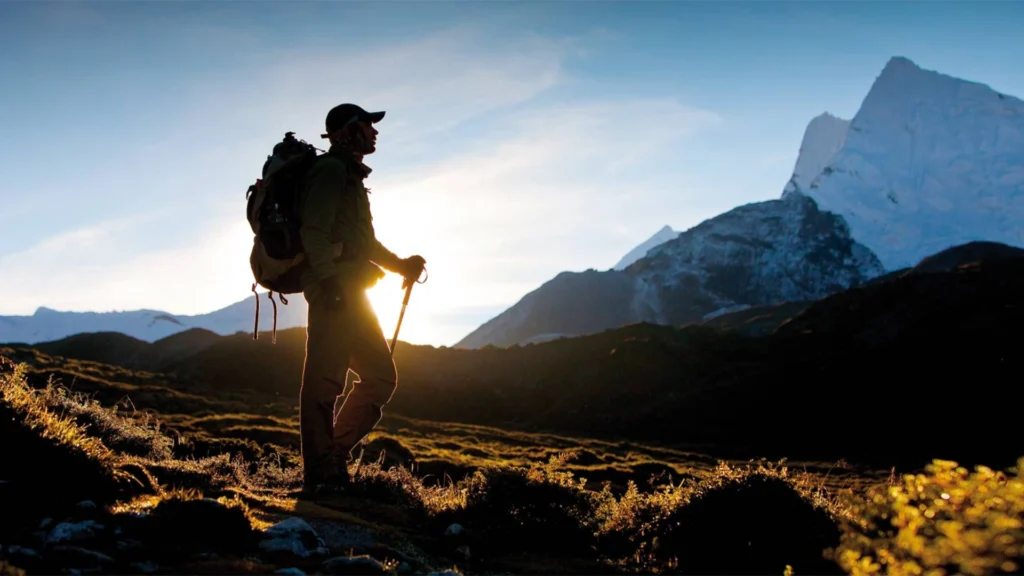
Essential Tips for Both Hiking and Trekking
Whether you’re planning a casual one-day hike or a multi-day trekking expedition, preparation is key to a safe and enjoyable outdoor experience. While commitment levels may vary, there are several universal tips every adventurer should follow. From building fitness to respecting nature, here are some must-have guidelines for both hiking and trekking enthusiasts.
1. Fitness Preparation
- Physical readiness is a must, especially when it comes to trekking. For hiking, moderate fitness is usually sufficient, and regular walking or light jogging can help you prepare for most trails.
- However, trekking often involves hours of walking, climbing steep trails, and carrying heavy backpacks. To prepare for a trekking trip, consider doing the following:
- Start endurance training at least 4-6 weeks before your trek.
- Focus on leg strength with exercises like lunges, squats, and stair climbing.
- Go on practice hikes with a weighted backpack to mimic real conditions.
- Incorporate cardio exercises like running or cycling to build stamina.
- Even if you’re starting with short hikes, building a strong fitness foundation will allow you to more easily progress to more challenging trekking adventures in the future.
2. Gear Checklist
Having the right gear can make or break your hiking or trekking experience. For day hikes, your checklist may be short, but for trekking, your gear must hold up to several days in rugged environments.
Basic hiking gear:
- Comfortable hiking shoes or boots
- Daypack with water, snacks, and sunscreen
- Navigation tool (map, GPS, or phone with offline maps)
- Clothing for the weather
Trekking gear essentials:
- Sturdy trekking boots with ankle support
- Large capacity backpack (50–70 liters)
- Tent or sleeping bag (if not available)
- Portable stove, cookware, and food
- Extra layers to protect against cold weather and rain
- Headlamp, trekking poles, and a first aid kit
Always pack light, but don’t compromise on the essentials—especially if you’re trekking in remote areas where supplies may not be available.
3. Safety basics
Safety should always come first, whether you’re hiking a local trail or trekking across mountain ranges. You should always remember to:
- Tell someone your route and expected return time.
- Check the weather forecast and trail conditions before setting out.
- Carry a whistle or emergency communication device.
- Stay hydrated and take regular breaks to avoid exhaustion.
- If you are trekking in high altitudes, understand the signs of altitude sickness and know when to descend.
- Being prepared can prevent minor problems from becoming major emergencies.
4. Environmental responsibility (leave no trace)
Both hikers and trekkers have a responsibility to protect their natural environment. The Leave No Trace principle applies to hiking trails and trekking routes alike:
- Pack out all trash, including food wrappers and biodegradable waste.
- Walk only on marked trails to avoid damaging delicate vegetation.
- Don’t disturb wildlife or pick off plants.
- Use eco-friendly gear and reusable water bottles to reduce your footprint.
- When trekking in remote areas, dispose of waste responsibly and avoid polluting water sources.
Respecting nature ensures that these beautiful trails remain intact for future generations of hikers and trekking enthusiasts.
Final Tips
Whether you are planning a short hike in the woods or an epic trekking adventure through the mountains, preparation and caution are a must. With the right fitness, gear, safety habits, and environmental awareness, you can enjoy the outdoors to the fullest while minimizing risk and protecting the planet.
So lace up your shoes, double-check your gear, and set out with confidence – because whether you are hiking or trekking, the path is waiting for you.
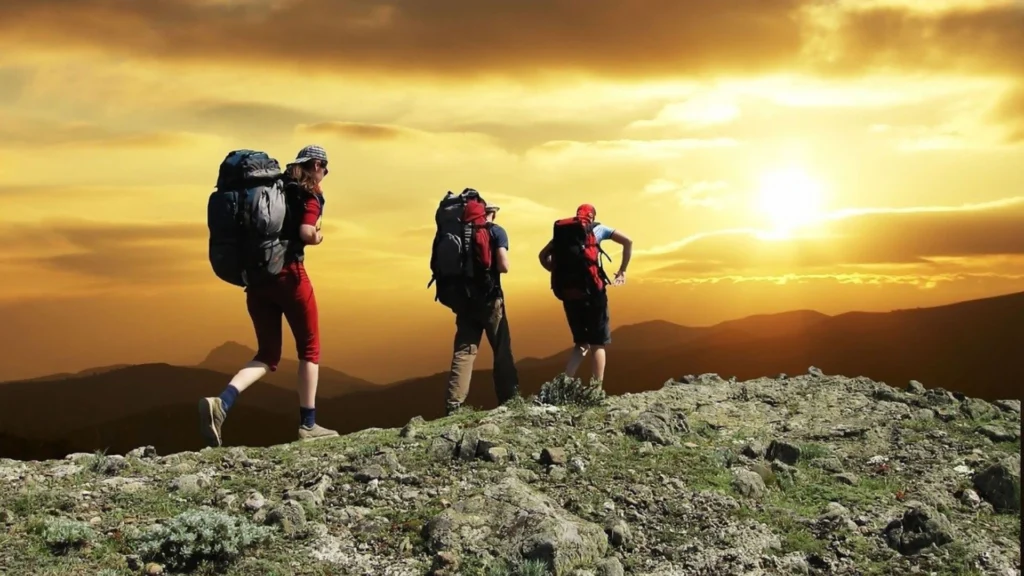
Conclusion: Your path awaits you
As we’ve discussed in this guide, both hiking and trekking are rewarding ways to connect with nature, but they’re suited to different types of outdoor adventurers.
Hiking is ideal for those who want a quick escape, an easy way to stay active, or a peaceful walk amid beautiful landscapes. It’s low-intensity, beginner-friendly, and requires minimal gear or planning. You can go hiking on the weekend, explore a nearby national park, and return home refreshed and recharged the same day.
Trekking, on the other hand, is a deeper and more immersive experience. It challenges your body, mind, and spirit over multiple days and challenging terrain. If you’re looking for remote adventures, cultural immersion, and a true test of endurance, it offers a powerful sense of accomplishment and transformation that few other activities can match.
Ultimately, your choice between hiking and staying depends on your personal goals, fitness level, available time, and appetite for adventure. The beauty is that you don’t have to choose just one. Try hiking to build confidence and stamina, and when you’re ready, take on the thrill of an expedition.
Both journeys lead to growth, breathtaking views, and unforgettable moments. So why limit yourself?
Are you a hiker or a trekker at heart? Let us know in the comments!
Whichever path you choose, just remember—every step brings you closer to nature and helps you discover a better version of yourself. Your path is waiting for you. Enjoy hiking or trekking!
Read about Sports with Duniya Sports

